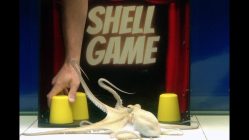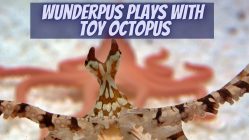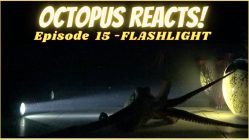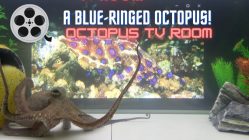
This is a species that goes by many names. Back in 1868 a species was described and attributed the scientific name of Octopus filosus. This name was considered a synonym of Octopus Vulgaris, so the scientific community decided to use the name O. hummelincki instead (which was used to describe the species in 1936) to refer to the species commonly known as the Caribbean Two-Spot Octopus, or Bumblebee Octopus, or Bumblebee two-spot octopus.
This small, tropical species is well-known for its amazing skin color and texture changes. It is often described as an active swimmer and it is easily recognized by the presence of two distinctive blue ocelli on its mantle.
Bumblebee Octopus Facts
- Scientific Name : Octopus hummelincki, Octopus filosus
- Common Name: Bumblebee Octopus, Caribbean Two-Spot Octopus, Bumblebee two-spot octopus
- Size: up to 25 cm
- Weight: up to 300 gr
- Lifespan: up to 2 years
- Found in: Western Atlantic
- Sub-Order: Incirrina
- Discovered: in 1936
- Scientific Name : Octopus hummelincki, Octopus filosus
- Common Name: Bumblebee Octopus, Caribbean Two-Spot Octopus, Bumblebee two-spot octopus
- Size: up to 25 cm
- Weight: up to 300 gr
- Lifespan: up to 2 years
- Found in: Western Atlantic
- Sub-Order: Incirrina
- Discovered: in 1936
This small, tropical species is easily recognized by the presence of two distinctive blue ocelli on its mantle.
—Another Reef Inhabitant—

This small benthic species can be found on tropical waters (22,8°C – 27,2°C) from the Gulf of Mexico to the Caribbean Sea, including Florida (most common around the Florida Keys) and the Bahamas on the north down to Panama and Venezuela and Brazil on the south.
It occurs most commonly in shallow waters, at no more than 200 meters depth, on both sandy and rocky bottoms. It is a coral reef inhabitant and likes to hide among the algae and shell rubble.
—How To Recognize The Bumblebee Octopus—

The Bumblebee Octopus is a very small species: the largest specimen ever found had a mantle length of 7 cm. Most individuals do not have a larger mantle than 2 cm long.
The most distinctive feature of the Caribbean Two-Spot Octopus is the ocellus which is located on its web at the base between the second and the third arm. The ocellus is a circular ring of vivid iridescent purplish-blue color.
This species can rapidly change the color and the patterns on its skin to camouflage effectively among the corals. It can grow conspicuous papillae and change from a light reticulated pattern to a dark mottled pattern. Most commonly observed is its mottled body pattern.
Observers have noted that the Bumblebee Octopus looks very similar to the frog fish (otherwise known as sargassum fish and anglerfish), which is a well-camouflaged fish that hides among the seaweed, as the Bumblebee Octopus also usually does.
—Conquering Senescence—

Back in 1977, the species was selected for an experiment that attempted to increase the octopus longevity.
Octopuses are senescent animals, meaning that they only reproduce once in their lifetime and then die. The female octopus will gradually stop eating as soon as she lays her eggs, and will die shortly after her last egg has hatched.
In this experiment, scientists removed the optic gland of female Bumblebee Octopuses to see if they will continue to feed after they lay their eggs. The result of the experiment was that the females that had the glands removed lived to up to nine months whereas the longest a female with an optic gland survived after laying eggs was only 51 days!
In other words, scientists discovered that the hormones produced by the optic gland regulate the female octopus’ breeding and feeding behavior. When the gland was removed, the female Bumblebee Octopuses stopped brooding their eggs, begun to feed once again, and some even resumed mating, but without being able to produce more eggs.











